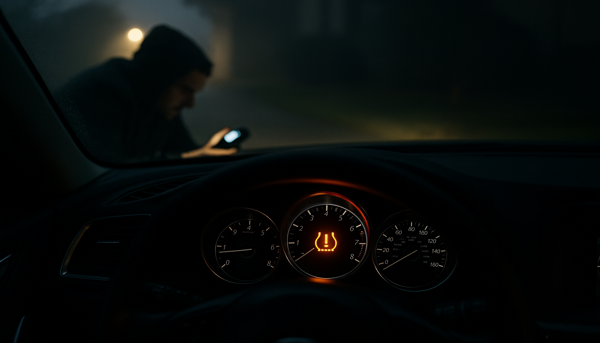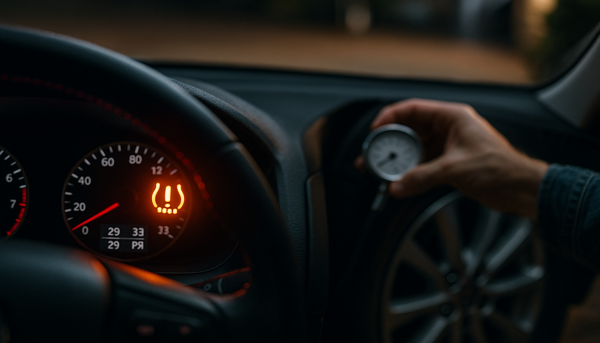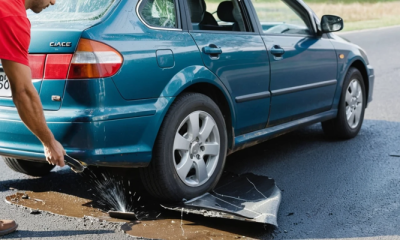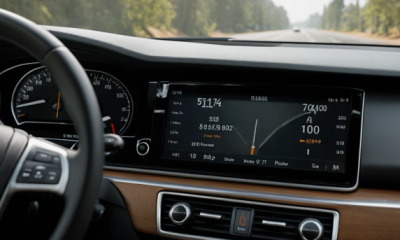Tires/Wheels
Blinking Tire Pressure Light – Fix It Fast & Drive Safe!

Blinking tire pressure light? Learn what tire pressure light blinking or flashing means, why it happens, and how to fix it before it leads to a serious issue.
Blinking Tire Pressure Light? Don’t Ignore This Warning!
Ever noticed that little tire icon blinking on your dashboard and thought, “Is this a big deal?”
Well, yes—it absolutely can be!
Your blinking tire pressure light isn’t just a suggestion. It’s your car yelling, “Hey, something’s wrong down here!” Ignoring it could mean more than just a flat tire. It could lead to poor gas mileage or even dangerous blowouts.
Let’s break down exactly what it means, what causes it, and how to fix it like a pro (without spending a fortune 💸).
🔍 What Does a Blinking Tire Pressure Light Mean?
First things first—what is that blinking really telling you?
A blinking tire pressure light usually means one of two things:
- Your tire pressure is dangerously low
- There’s a problem with the TPMS (Tire Pressure Monitoring System)
If the light blinks for 60–90 seconds, then stays solid, it’s most likely a TPMS malfunction. If it stays on continuously, it usually means at least one tire is under-inflated.
So, if your light’s going crazy—don’t ignore it. Let’s get into the nitty-gritty. 🔧
🛠️ Common Causes of a Blinking Tire Pressure Light
Let’s go over the main culprits behind that annoying blinking light:
- Low air pressure in one or more tires
- Sudden temperature drops (yes, cold weather can trigger it!)
- TPMS sensor battery failure
- Faulty TPMS sensors
- Tire leak or puncture
- Wheel replacement without sensor reset
Not sure which one is messing with your ride? The next sections will help you figure it out step by step. 🧩
❄️ Cold Weather & Tire Pressure – A Surprising Connection
Did the blinking start on a chilly morning? ❄️ You’re not alone.
Tires lose 1 PSI for every 10°F drop in temperature. So if last week was 70°F and today it’s 30°F—you could lose up to 4 PSI, just like that.
And guess what? Most TPMS lights trigger at just 25% pressure loss.
Quick Tip:
Always check your tire pressure when tires are cold, not after you’ve been driving.
📉 Why Driving on Low Tire Pressure Is Risky
Ignoring a low tire warning doesn’t just cost you gas money—it puts you in danger. Here’s why:
- Increased blowout risk
- Longer stopping distances
- Worse handling and traction
- Lower fuel economy
- Faster tire wear
Pro Tip: If your tire is 20% underinflated, it wears out 25% faster. Ouch. 😬

👣 Step-by-Step: What To Do When the Light Blinks
Let’s fix this the easy way. Here’s a simple checklist:
- Park safely and turn off your car.
- Visually inspect all four tires.
- Use a digital pressure gauge to check each tire’s PSI.
- Compare readings with your car’s recommended PSI (usually on the driver’s door label).
- Inflate or deflate as needed.
- If pressure is normal but the light keeps blinking, it’s likely a TPMS sensor issue.
🧰 Tools You’ll Need to Check Tire Pressure
Here’s a quick look at the basic gear you need to solve this issue:
| Tool | Purpose | Where to Get It |
|---|---|---|
| Tire Pressure Gauge | Measures PSI | Auto parts store, Amazon |
| Air Compressor | Inflates underinflated tires | Gas stations, Walmart |
| TPMS Reset Tool | Reprograms tire sensors | Online or mechanic shop |
These tools are easy to find and super affordable—many cost under $20!
🚗 When to Reset Your TPMS (And How)
After adjusting tire pressure, the light should go off on its own. If not, you might need to reset the system.
Here’s how to reset TPMS manually (in many cars):
- Turn your car to the “ON” position (engine off).
- Hold the TPMS reset button (under the steering wheel) until the light blinks 3 times.
- Start the car. Drive for 15–20 minutes at above 30 mph.
Stil blinking? You may need a TPMS tool or professional diagnostic. 🧑🔧
🧠 How TPMS Sensors Actually Work
Ever wonder what’s going on inside those little black sensors?
TPMS sensors are either direct or indirect:
- Direct sensors measure the exact pressure in each tire.
- Indirect sensors use ABS wheel speed data to estimate pressure.
Important: Most modern cars use direct sensors, which have small batteries that last around 7–10 years. When they die, you’ll likely get the dreaded blinking light.
🧪 TPMS Error vs. Low Tire Pressure – How to Tell
Can’t tell whether it’s just low pressure or a system malfunction? Here’s a side-by-side comparison:
| Symptom | Cause | What It Means |
|---|---|---|
| Light blinks, then stays | TPMS sensor issue | Needs reset or replacement |
| Light stays solid | Low tire pressure | Check & inflate tires |
| Light comes on randomly | Temperature fluctuation | Check PSI, monitor closely |
This table helps you quickly identify what you’re dealing with so you don’t second-guess it.
⏰ When to Call a Mechanic
If you’ve tried everything—checked pressure, reset TPMS, inspected tires—and the light is on, it’s time to call a mechanic.
Seek help if:
- Light blinks for more than a week
- You recently replaced tires or wheels
- Tires look fine, but you feel vibration or poor handling
- Your TPMS battery is over 7 years old
A good mechanic can run a sensor diagnostic and find hidden issues in minutes.
💰 How Much Does It Cost to Fix?
Worried about costs? Don’t be. Here’s what to expect:
| Service | Average Cost |
|---|---|
| Inflate tires at gas station | Free – $2 |
| TPMS reset or reprogram | $35 – $80 |
| Replace faulty sensor | $50 – $150 per tire |
Tip: If your car is under warranty, the fix might be free!
🧼 Prevent It From Happening Again
Want to avoid seeing that light blink ever again? Here’s how:
- Check tire pressure monthly
- Inflate to the recommended PSI
- Rotate tires every 6,000–8,000 miles
- Replace sensors every 7–10 years
- Avoid potholes and curb hits 🚧
Good tire care = no dashboard drama. 😎
🧊 Seasonal Tire Pressure Checks Are a Must
Seasons change—and so does your tire pressure!
In winter: PSI drops fast, so check often.
In summer: Overinflation can be an issue—watch those numbers.
Use this seasonal guide:
| Season | Check Frequency | Common Issue |
|---|---|---|
| Winter ❄️ | Weekly | Underinflation |
| Summer ☀️ | Bi-weekly | Overinflation |
| Fall 🍁 | Bi-weekly | Fluctuations |
| Spring 🌸 | Monthly | Sensor recalibration |
🚧 Can I Drive With the Light Blinking?
Short answer? You shouldn’t.
Even if your car feels fine, driving with low tire pressure or a faulty TPMS is dangerous.
You risk:
- Sudden tire blowouts
- Uneven tire wear
- Poor fuel efficiency
- Failing a safety inspection
So don’t just hope it goes away. Handle it ASAP. 🚨
🏁 Final Thoughts: That Blinking Light Means Business
Your blinking tire pressure light isn’t just annoying—it’s a warning that could save your life.
Whether it’s a simple fix or a sensor issue, the key is not to ignore it.
Check. Inflate. Reset. Repeat.
Treat that little icon like a VIP guest—it’s there to keep you safe on the road. 🛣️
❓FAQs: Tire Pressure Light Blinking
What causes a blinking tire pressure light?
It’s usually caused by low air pressure or a faulty TPMS sensor. Cold weather can also trigger it.
Can I drive with the tire pressure light on?
It’s not recommended. Low tire pressure can lead to dangerous blowouts or poor handling.
How do I fix the blinking tire light?
Check all tires for proper PSI, inflate if needed, and reset the TPMS if the light stays on.
Why does my tire light blink then stay on?
This pattern means the TPMS sensor is malfunctioning. It needs to be reset or replaced.
How much does it cost to replace a tire sensor?
Expect to pay $50 to $150 per sensor. Some shops may include installation in that price.
-

 Care & Repairs3 weeks ago
Care & Repairs3 weeks agoHandling Vehicle Damage after an Accident: Smart Repair Tips for Peace of Mind
-

 Auto Parts3 weeks ago
Auto Parts3 weeks agoCheapest Online Store For Car Parts – Best Deals Guaranteed
-

 Auto Parts4 weeks ago
Auto Parts4 weeks agoFind Auto Parts Using VIN Number – Fast & Easy Method Today!
-

 Auto Parts3 weeks ago
Auto Parts3 weeks agoUsed Auto Parts with Warranty: Smart, Reliable & Budget-Friendly!






